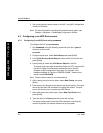
Novell NetWare
4-8 July 1998
N
O
V
E
L
L
N
E
T
W
A
R
E
¥ When logged in to an NDS environment as an NDS Print Server, you
should conÞgure the print server with only one NDS Printer object. You
specify parameters, such as which port to send data (LPT or COM) by
creating special queue name sufÞxes.
The major differences between conÞguring a Kodak printer/NIC to
service bindery or NDS queues areÑ
¥ When using Bindery queues, users may modify the setting in the
printer/NIC called Preferred Server. This refers to the Bindery File
Server that holds the conÞguration Þle.
¥ When servicing NDS queues, the printer must be conÞgured with a
context name, and may be conÞgured (optionally) with a tree name.
This can be done with FastManage.
¥ When conÞgured for NDS, the printer does not use a conÞguration Þle.
It logs into the context where it was conÞgured, locates the printer and
queues that it should service.
¥ Regarding manual conÞguration of print server, queues, and printers
(within PCONSOLE or NWadmin): Bindery print servers are directly
attached to bindery print queues. NDS print servers are attached to a
single printer, which in turn is potentially attached to many print
queues.
When conÞgured to service both Bindery and NDS queues, the NIC does
the following:
1. At startup, the NIC tries to locate an NDS server.
2. Once it locates the server, the NIC looks at the context it has been
conÞgured with, and tries to log in as print server KDxxxxxx (the xxxs
are the six-digit hardware address).
3. Once successful, the NIC gets the printer attribute of that print server,
and then gets the list of print queues that the printer should service.
4. The NIC attaches to those print queues and moves on to the next
phase.
Note: If a context was not speciÞed in the NIC NVRAM, the NIC will not
log into the NDS tree.
5. The NIC then tries to locate normal Bindery Þle servers.


















